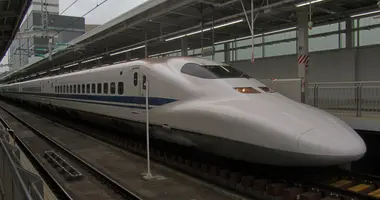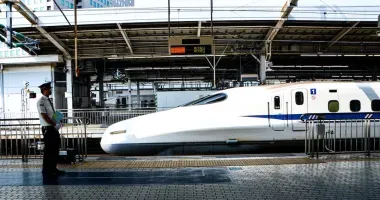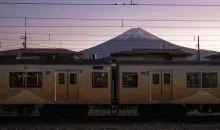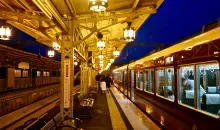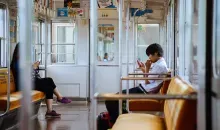Sanyo Shinkansen: Your guide to Japan's western bullet train line
- Published on : 05/04/2024
- by : Japan Experience
- Youtube
The Sanyo Shinkansen is a high-speed bullet train line connecting major cities in western Japan. It runs from Shin-Osaka to Hakata (Fukuoka), passing through Kobe, Himeji, Okayama, and Hiroshima. The line is operated by JR West and connects to the Tokaido Shinkansen and Kyushu Shinkansen. Using the Sanyo Shinkansen is a fast and convenient way to explore western Japan's top destinations.
History and route of the Sanyo Shinkansen
The Sanyo route, historically known as the San'yōdō, was an important feudal trade route in Japan. It ran approximately 350 miles from Kyoto in the east to Shimonoseki in the west, from where travelers could continue by boat to Kyushu. The term "Sanyo" means the sunny side of the mountains, referring to the southern part of the Chūgoku region facing the Seto Inland Sea. This area includes major cities like Okayama, Hiroshima and Yamaguchi.
Construction of the Sanyo Shinkansen line began in 1967 and opened in stages, with the Shin-Osaka to Okayama segment completed in 1972 and the remainder to Hakata in 1975. Key stations served along the route include Shin-Kobe, Himeji, Okayama, Hiroshima, and Hakata. The line connects to the Tokaido Shinkansen at Shin-Osaka for services to/from Tokyo, and to the Kyushu Shinkansen at Hakata for onward travel to Kyushu.
Train services and timetables
Five types of trains operate on the Sanyo Shinkansen line:
- Nozomi - The fastest service, stopping only at major stations with a travel time of about 2.5 hours between Shin-Osaka and Hakata. Runs up to three times per hour.
- Mizuho - A limited-stop service providing through service to the Kyushu Shinkansen to/from Kagoshima. Operates a few round trips per day, mainly in the mornings and evenings.
- Hikari - A semi-fast service stopping at more stations than the Nozomi. One Hikari train per hour from Tokyo continues along the Sanyo Shinkansen as far as Okayama.
- Sakura - Connects Shin-Osaka to Kagoshima on the Kyushu Shinkansen, making a few more stops than the Mizuho. Runs about once per hour.
- Kodama - The slowest service that stops at every station, taking around 5 hours between Shin-Osaka and Hakata. Operates about twice per hour.
Peak travel periods, especially during Japanese holidays like Golden Week, Obon, and New Year, can get very busy with some trains becoming fully reserved. It's important to understand the different train types and plan accordingly to suit your travel schedule and destinations.

Sanyo-Shinkansen Map
By そらみみ - Own work, CC BY-SA 4.0, https://commons.wikimedia.org/w/index.php?curid=59421775
Using the Japan Rail Pass on the Sanyo Shinkansen
The Japan Rail Pass covers travel on the entire Sanyo Shinkansen route, except for the Nozomi and Mizuho trains. Pass holders can make free seat reservations for the Hikari, Sakura, and Kodama trains at ticket offices in larger stations along the line like Shin-Osaka, Hiroshima, and Hakata.
Several regional JR West passes also provide coverage on the Sanyo Shinkansen, some of which allow travel on the Nozomi and Mizuho for pass holders. These include the JR Sanyo Sanin Area Pass, JR Kansai Hiroshima Area Pass, and others.
From October 2023, nationwide Japan Rail Pass holders will be able to ride the Nozomi and Mizuho trains by paying a supplement fee. This will provide more convenient and flexible options for exploring destinations along the Sanyo Shinkansen.
Onboard facilities and services
Sanyo Shinkansen trains offer comfortable amenities and services for passengers:
- Seating options include ordinary reserved and non-reserved seats in a 3x2 configuration, as well as spacious Green Car (first class) seats arranged 2x2.
- Luggage can be stored in the overhead racks or behind the last row of seats in each car. Travelers with oversized baggage between 160-250cm in total dimensions need to reserve special luggage areas.
- Onboard amenities include electrical outlets, free Wi-Fi, and large picture windows for enjoying scenic views. Some trains feature unique designs like the Hello Kitty Shinkansen.
- Most trains are equipped with vending machines selling drinks and snacks, while a food and beverage cart provides at-seat service. Many stations have ekiben (station bento) shops selling delicious boxed meals to enjoy on your journey.
- Restrooms, including spacious accessible facilities, are available. Smoking is not allowed on board but some trains have a smoking room.
Destinations and sightseeing along the Sanyo Shinkansen route
The Sanyo Shinkansen provides easy access to a wealth of cultural and natural attractions across western Honshu. Himeji is home to Japan's most spectacular feudal castle, while Okayama boasts the famous Korakuen landscape garden and is a gateway to the art islands of the Seto Inland Sea.
Hiroshima, rebuilt following the 1945 atomic bombing, offers poignant peace memorials and the sacred island shrine of Miyajima. Hakata Station in Fukuoka is a jumping off point for exploring Kyushu, with onsen hot springs, volcanoes, and historic sites all within easy reach.
Many stations host seasonal events and festivals showcasing the unique culture, cuisine, and crafts of each region. Sampling local specialties like Kobe beef, Hiroshima-style okonomiyaki savory pancakes, and Hakata ramen adds delicious flavors to any journey through western Japan.
Tips for riding the Sanyo Shinkansen
Here are some useful tips for making the most of your Sanyo Shinkansen trip:
- Buy tickets and make seat reservations in advance, especially during peak seasons, to guarantee your preferred trains and seats. Reservations can be made online or at ticket offices.
- Arrive early to navigate the station, find your platform, and line up at the marked boarding areas. Train doors only open for a short time.
- Follow onboard etiquette - keep noise to a minimum, set mobile devices on silent, and refrain from eating strong-smelling foods.
- Have your rail pass or ticket ready for easy inspection, along with any reserved seat tickets. Stations have signage in English to help you find your way.
- Store luggage properly and be mindful of other passengers, especially in the non-reserved cars which can get crowded.
By taking note of these tips, you're sure to enjoy a pleasant and speedy bullet train ride through the dynamic cities and enchanting landscapes of western Japan.
The future of the Sanyo Shinkansen
Several developments are underway to further improve Sanyo Shinkansen services and passenger comfort in the coming years:
- Introduction of N700S series trains to replace older models and boost capacity while reducing environmental impact.
- Extension of platforms to accommodate longer 16-car trains and alleviate congestion.
- Improvements to accessibility, including more barrier-free stations and train facilities.
- More seamless connections to other transit services like subways, buses, and airports.
- Potential extensions to new destinations in Kyushu and beyond, pending feasibility studies.
With ongoing enhancements to infrastructure, technology, and the overall travel experience, the Sanyo Shinkansen is on track to remain one of the world's premier high-speed rail journeys - whisking passengers between the vibrant cities of western Japan in safety, comfort and style.

